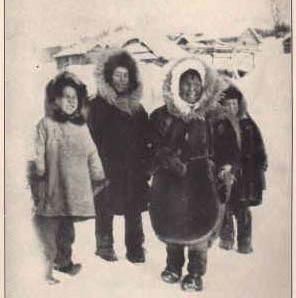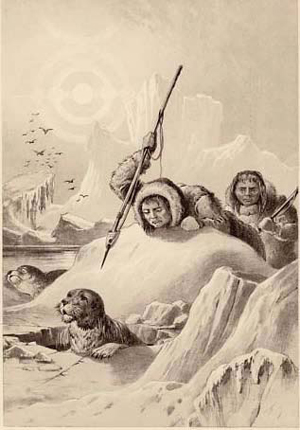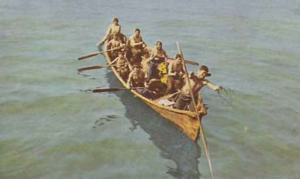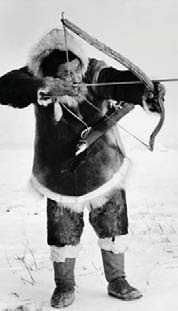
Since learning about them as a child, whenever I would hear the word “Eskimo,” I would think of a stocky person wrapped in animal skins and furs, setting out from an igloo with harpoon in hand to hunt for the family’s meal. These people seemed as different from me as creatures from another planet. To imagine that many of them lived in one of the states in the same nation, as I, seemed unfathomable.
Yet, Eskimos are part of a group of Aboriginal people that has lived for centuries along the coastline from the Bering Sea to Greenland, and the Chukchi Peninsula in Northeast Siberia, all within the Arctic Circle. Because the various groups are so spread out, Eskimos were once believed to be survivors of Ice Age cultures. However, the groups kept in close communication, and though each is distinct from the others in their hunting and resource use, they all speak dialects of the Eskimo language, and share physical traits and cultural practices, commonalities that differentiate them from their inland neighbors.
Today, the term Eskimo is considered an old, general term used by European explorers to refer to many groups of people. Once incorrectly thought to translate as “eaters of raw flesh,” Eskimo is now believed to be a reference to snowshoes, yet it is still considered derogatory in the Canadian settlements. Eskimo groups in Canada and Greenland have preferred the name “Inuit” since the 1970s. This name, which means “The People” in Inuktitut, the Canadian Eskimo language, has not taken hold in Alaska.
 To understand Eskimo contemporary culture requires a look at their history. Eskimos were nomadic hunter-gatherers who hunted seal in the winter, whales in the spring and follow caribou in the summer. Their diet was practically devoid of vegetables as trees were scarce. Primary sources of nutrition were fish, seal meat, whale meat and blubber, walrus and caribou.
To understand Eskimo contemporary culture requires a look at their history. Eskimos were nomadic hunter-gatherers who hunted seal in the winter, whales in the spring and follow caribou in the summer. Their diet was practically devoid of vegetables as trees were scarce. Primary sources of nutrition were fish, seal meat, whale meat and blubber, walrus and caribou.
Artisans of elaborate technologies, Eskimos did their winter hunting with harpoons either on the ice or from kayaks – one-person canoes covered with animal skin – or larger boats called umiaks, all of which they built themselves. Winter dwellings were igloos, made from blocks of snow, or houses built from stone, and summer camps were filled with tents made from seal or walrus skins. They traveled primarily by dogsled, and Shamanism was the main spiritual practice.
Shamanism is based on the belief in guardian spirits who most often take on animal forms. These spirits are said to help guide the souls of the dead on their post-mortem voyage to the great beyond, as well as protect the living and insure abundant amounts of food. A shaman, or angakok, is literally translated as “one who knows.” Considered a powerful leader, the shaman is seen as a mediator between the human and spiritual worlds. Through visions and trances, the shaman confers with the spirit world, and declares what sacrifices should be made or dances should be done to insure a successful hunt, or to heal someone who is ill.
The speed of cultural evolution of many aboriginal people in the arctic region since the 1940s has been exponential compared to the thousands of years prior. The Inuit way of life, once a self-sustaining and closely woven community, has been altered dramatically because of the white man’s influence. Traditional Inuit social roles were very strict: Men would hunt, women would care for the home and family, and children were taught hunting, fishing, animal cleaning, food preparation, tanning and other life skills, so that by the age of puberty, they would be able to provide and care for their own family. After World War II, Arctic Canada became more accessible with the development of modern aircraft, and the construction of military bases. The Inuits’ contact with European society grew, and as a result, they began dying of diseases spread from these bases.
 The Canadian government wanted Inuit children to attend school so they could learn to read and write in English or French, as well as being able to identify their numbers. As a result, the government began creating Inuit settlements. Inuit children were placed in residential schools, and though their families wanted to remain on the land, many of them ultimately settled in towns so they could be near them. The introduction of consumer goods, regular visits from doctors, a shift toward a money-based economy, and public education, with its foreign language and values, were the main influences on the aboriginal people.
The Canadian government wanted Inuit children to attend school so they could learn to read and write in English or French, as well as being able to identify their numbers. As a result, the government began creating Inuit settlements. Inuit children were placed in residential schools, and though their families wanted to remain on the land, many of them ultimately settled in towns so they could be near them. The introduction of consumer goods, regular visits from doctors, a shift toward a money-based economy, and public education, with its foreign language and values, were the main influences on the aboriginal people.
Better medical care meant that many of the Eskimos lived longer, which caused an increase in the Inuit population and put a strain on their ecosystem. With more people living longer, hunting and fishing could no longer support their growing numbers. Ultimately, the prospect of government services, paid jobs, and an escape from increasing hunger, caused the Inuits to move to permanent settlements by the mid-1960s. In this way, over the course of a mere two generations, these once self-sufficient people had become a poor minority without job skills or resources useful in the larger economy, while at the same time, they became increasingly dependent upon this new society for their survival.
Rather than die out, young Inuits, fueled by the knowledge gained in their new schools, became activists for their people. Land claims settlements across Canada over the next two decades gave the Inuits increasing autonomy, and a representative voice in the government. In addition, in 1999, Nunavut was created in the Northwest Territories to be self-governing and primarily populated by Inuits. Inuits also have a strong presence in both visual and performance art in Canada and Greenland. Represented by numerous Canadian and Alaskan agencies, these native people continue to perpetuate traditions such as dancing, storytelling, and other important cultural facets. Inuktitut is still spoken across the arctic region, and television stations like Inuit Broadcasting Corporation, and radio programming commonly broadcast in Inuktitut as well.
Although the majority of Eskimos today live in settlements, work for wages, and hunt with guns, thus adapting to the changes that have come their way over the last half century, some still suffer from joblessness, poverty, and alcoholism. While they hunt for some of their food, they still have to buy some things, and because supplies are flown in, they are expensive. To attend high school and college, children must move away from home; this can be very lonely for students who have grown up in a closely-knit community.
 Today’s young generation of Inuit has also struggled significantly with identity issues. The difference between the Western culture that so strongly influences them today, and the fact that they cannot maintain a viable livelihood, plus the traditional heritage of their people, instilled in them from their families and elders, are seemingly mutually exclusive. However, many organizations across Canada are in place for the sole purpose of aiding aboriginal people in various aspects of their lives, including the Arctic Children and Youth Foundation, and the National Inuit Youth Council, both of which aim to facilitate communication, prevent substance abuse and suicide, and enhance educational opportunities for aboriginal youth.
Today’s young generation of Inuit has also struggled significantly with identity issues. The difference between the Western culture that so strongly influences them today, and the fact that they cannot maintain a viable livelihood, plus the traditional heritage of their people, instilled in them from their families and elders, are seemingly mutually exclusive. However, many organizations across Canada are in place for the sole purpose of aiding aboriginal people in various aspects of their lives, including the Arctic Children and Youth Foundation, and the National Inuit Youth Council, both of which aim to facilitate communication, prevent substance abuse and suicide, and enhance educational opportunities for aboriginal youth.
In addition to this, technology has brought significant advantages to the Inuits. Rather than living and working in total isolation, the Inuits utilize modern communication tools to remain connected to each other. Snowmobiles and all-terrain vehicles make hunting and traveling easier. And, while they recognize the importance of letting the children learn English, French, and computers, the Inuit do their best to instill their native language, history, and traditions in their children so that their culture is not lost.
To celebrate the aboriginal cultures and heritage, several events are scheduled in Canada and the northwest throughout this summer. On June 21, the day of the summer solstice, marks the 14th National Aboriginal Day, celebration. On this day of recognition, local and regional festivals across Canada let aboriginal groups share their cultural heritage, and teach Canadians about the traditions, and contributions these people have made.
In July, the 49th annual World Eskimo-Indian Olympics, will be held in Fairbanks, Alaska. The event, which takes place over the 4th of July and Christmas holidays, include games that use survival skills. With names like Kneel Jump and Two-Foot High Kick, the events are intended to utilize the abilities that Eskimos would have used in their everyday lives. Some require moves that simulate the balance and quickness, they need to utilize while out on moving ice during breaking up season, for example, while others call on the physical strength one would need to help beach a whale after catching it. Also in July is the Great Northern Arts Festival, from the 9th through the 18th in Inuvik, Northwest Territories, Canada. Visual artists and performers gather to celebrate the diversity of the aboriginal people, and include Inuit, Inuvialuit, Gwich'in, Dene, Metis, and more.
Considering how different the Eskimo way of life is from Western society, their strength has enabled them to make great strides in adapting, and sharing their cultural treasures and heritage with the rest of the world. For that, we all benefit.
Bibliography
Burland, Cottie. North American Indian Mythology. "Library of the World's Myths and Legends." {Revised by Marion Wood) New York. Peter Bedrick Books. 1965. pp. 19-20.
Encyclopedia Britannica Online, 2010.
Alaska Native Heritage Center.
Harper, Judith R. Inuits. Mankato, Minnesota. Smart Apple Media, 2000.
Williams, Suzanne M. The Inuit. Watts Library, a Division of Scholastic, Inc. 2003.
The Columbia Electronic Encyclopedia, 6th ed. 2007, Columbia University Press.

Comments
Eskimos
It's funny, and I feel ignorant, because I never really thought about Eskimos as a race or as a particular culture. You hear about them in fictional movies so often, you almost forget that they are a real and thriving group of people. Very informative!